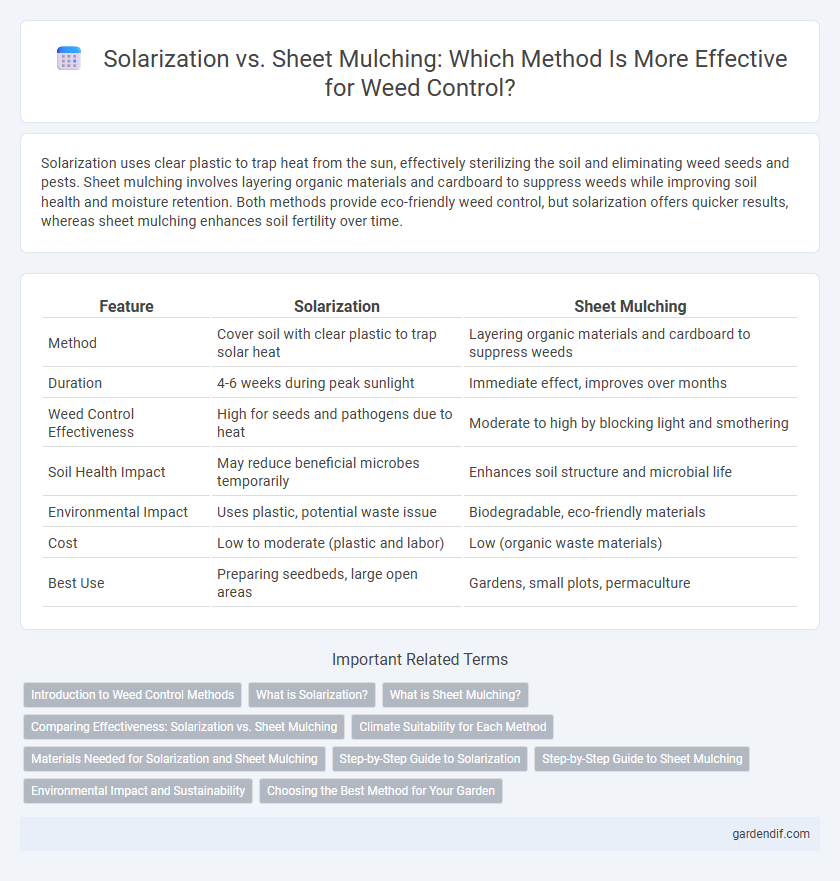
Solarization vs Sheet Mulching Illustration
Solarization uses clear plastic to trap heat from the sun, effectively sterilizing the soil and eliminating weed seeds and pests. Sheet mulching involves layering organic materials and cardboard to suppress weeds while improving soil health and moisture retention. Both methods provide eco-friendly weed control, but solarization offers quicker results, whereas sheet mulching enhances soil fertility over time.
Table of Comparison
| Feature | Solarization | Sheet Mulching |
|---|---|---|
| Method | Cover soil with clear plastic to trap solar heat | Layering organic materials and cardboard to suppress weeds |
| Duration | 4-6 weeks during peak sunlight | Immediate effect, improves over months |
| Weed Control Effectiveness | High for seeds and pathogens due to heat | Moderate to high by blocking light and smothering |
| Soil Health Impact | May reduce beneficial microbes temporarily | Enhances soil structure and microbial life |
| Environmental Impact | Uses plastic, potential waste issue | Biodegradable, eco-friendly materials |
| Cost | Low to moderate (plastic and labor) | Low (organic waste materials) |
| Best Use | Preparing seedbeds, large open areas | Gardens, small plots, permaculture |
Introduction to Weed Control Methods
Solarization and sheet mulching are effective weed control methods utilizing different mechanisms to suppress unwanted vegetation. Solarization employs solar heat captured under clear plastic to thermally eradicate weed seeds and seedlings, proving highly efficient in warm, sunny climates. Sheet mulching combines layers of organic materials to block light and improve soil health while preventing weed growth through physical barrier effects.
What is Solarization?
Solarization is a non-chemical weed control method that uses solar energy to heat the soil, effectively killing weed seeds, pathogens, and pests by raising soil temperatures to levels lethal for these organisms. This process involves covering moist soil with transparent plastic sheets for 4 to 6 weeks during the hottest part of the year, allowing the sun's heat to penetrate and sterilize the soil. Solarization improves soil health by reducing weed pressure without harmful chemicals, making it an eco-friendly alternative to traditional herbicides.
What is Sheet Mulching?
Sheet mulching is a sustainable gardening technique that suppresses weed growth by layering organic materials such as cardboard, newspaper, and compost directly on the soil surface. This method improves soil fertility, retains moisture, and enhances microbial activity while blocking sunlight to inhibit weed seeds from germinating. Unlike solarization, which uses plastic covers and heat to sterilize soil, sheet mulching promotes long-term soil health and gradual weed control through natural decomposition processes.
Comparing Effectiveness: Solarization vs. Sheet Mulching
Solarization uses solar heat trapped by clear plastic to kill weed seeds and soil pathogens, proving highly effective in areas with strong sunlight and warm climates. Sheet mulching suppresses weeds by creating a thick, organic barrier that blocks light and improves soil health, offering longer-term weed control but slower initial results. Solarization provides rapid weed seed sterilization, while sheet mulching excels in sustainable weed suppression and soil ecosystem enhancement.
Climate Suitability for Each Method
Solarization is highly effective in hot, sunny climates where temperatures consistently exceed 85degF (29degC), as intense heat trapped under plastic sheets kills weed seeds and soil pathogens. Sheet mulching performs better in temperate or cooler climates by suppressing weeds through layered organic materials that improve soil moisture and structure without relying on extreme heat. Both methods contribute to sustainable weed control, but selecting the technique that aligns with local climate conditions maximizes effectiveness and soil health.
Materials Needed for Solarization and Sheet Mulching
Solarization requires clear plastic sheets, preferably UV-resistant polyethylene, to trap solar heat, along with soil moisture and garden stakes to secure the plastic tightly. Sheet mulching involves layering organic materials such as cardboard or newspaper for weed suppression, followed by compost, mulch, and sometimes nitrogen-rich amendments to enhance soil fertility. Both methods need preparation tools like garden rakes and watering equipment to ensure effective implementation.
Step-by-Step Guide to Solarization
Solarization involves covering moist soil with clear plastic sheets during sunny months to trap solar energy and kill weed seeds and pathogens through high soil temperatures. The process begins with clearing the area of debris, tilling the soil, and watering thoroughly before laying the plastic sheets tightly over the soil, securing edges with soil or rocks to prevent heat loss. After 4 to 6 weeks of solar exposure, the soil achieves temperatures sufficient to eliminate most weed seeds, making it a sustainable and chemical-free method for weed control.
Step-by-Step Guide to Sheet Mulching
Sheet mulching effectively suppresses weed growth by layering organic materials to block sunlight and improve soil health. Begin by mowing the area, then lay down cardboard or newspaper sheets to create a weed barrier, followed by a thick layer of compost, mulch, and organic matter to enrich the soil and retain moisture. This technique promotes beneficial microbial activity and reduces the need for chemical herbicides, making it a sustainable alternative to solarization for long-term weed control.
Environmental Impact and Sustainability
Solarization harnesses solar energy to heat the soil, effectively reducing weed seeds and pathogens without chemical use, making it an environmentally friendly method. Sheet mulching improves soil structure and moisture retention while suppressing weeds through organic layers, promoting sustainable gardening by enhancing biodiversity and reducing waste. Both techniques minimize reliance on herbicides, but sheet mulching typically offers longer-term soil health benefits and greater carbon sequestration.
Choosing the Best Method for Your Garden
Solarization uses clear plastic to trap solar energy, effectively heating soil to temperatures that kill weed seeds and pathogens, making it ideal for sunny gardens with ample sunlight. Sheet mulching involves layering organic materials like cardboard and compost to suppress weeds, improve soil fertility, and retain moisture, perfect for gardeners seeking a sustainable, nutrient-rich approach. Evaluate your garden's sunlight exposure, soil condition, and long-term soil health goals to select the most effective weed control method.
Solarization vs Sheet Mulching Infographic

 gardendif.com
gardendif.com